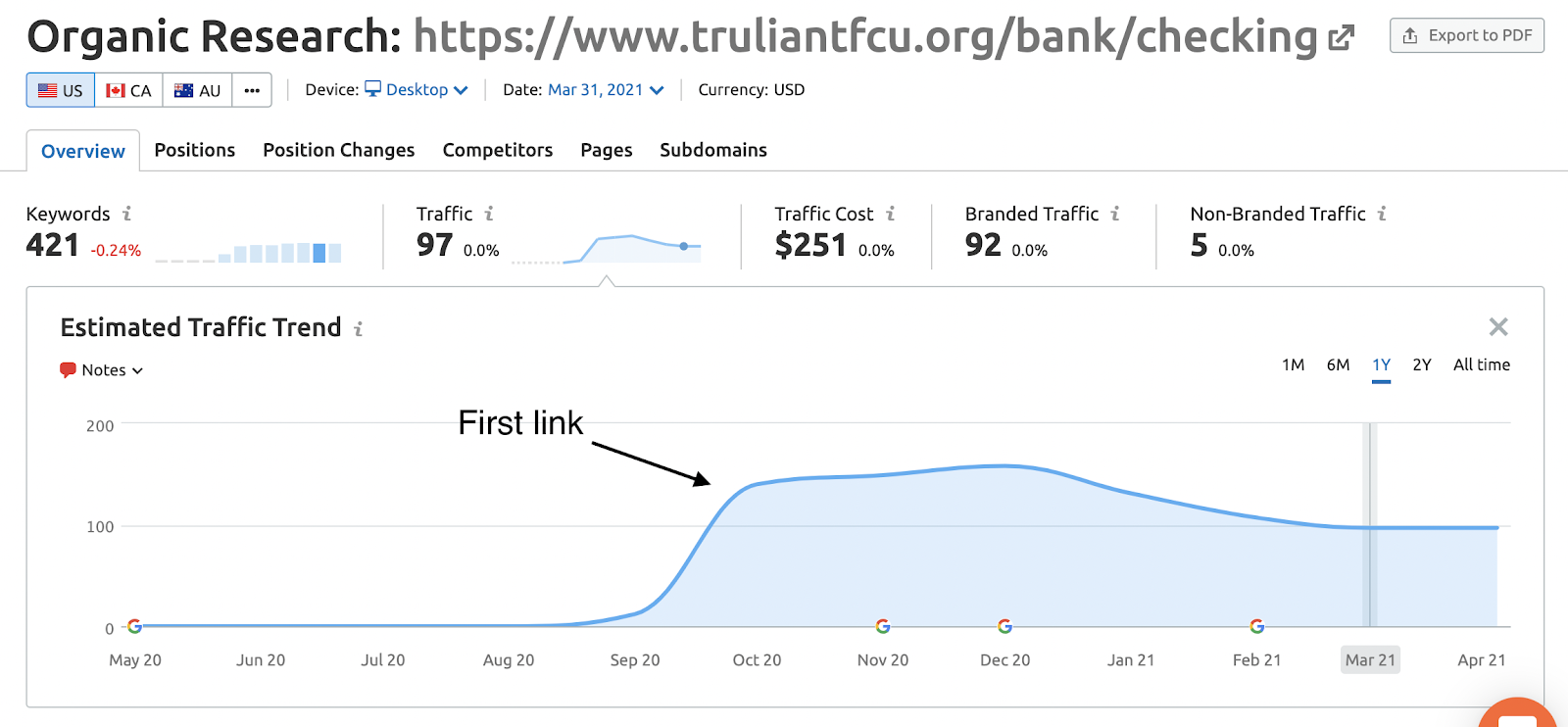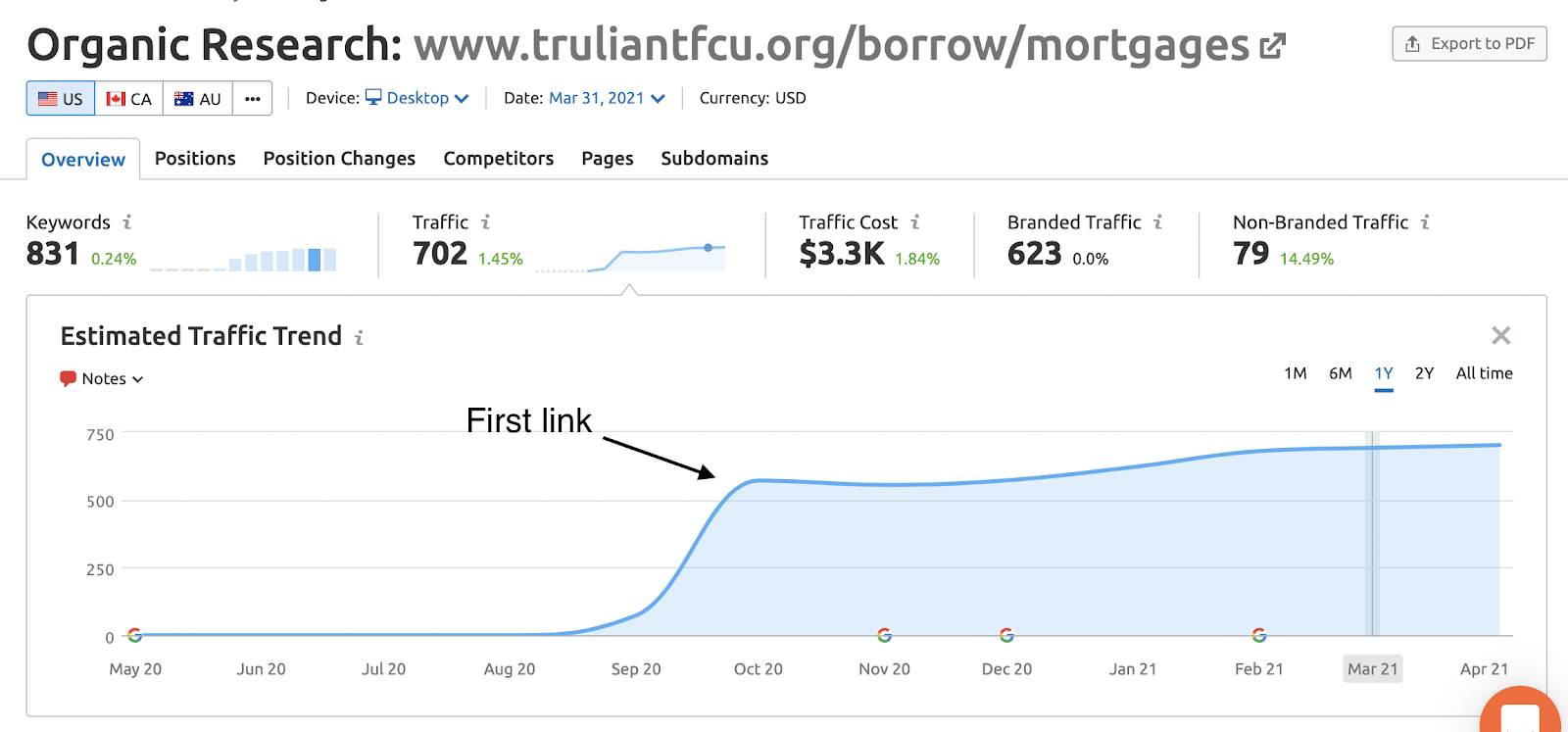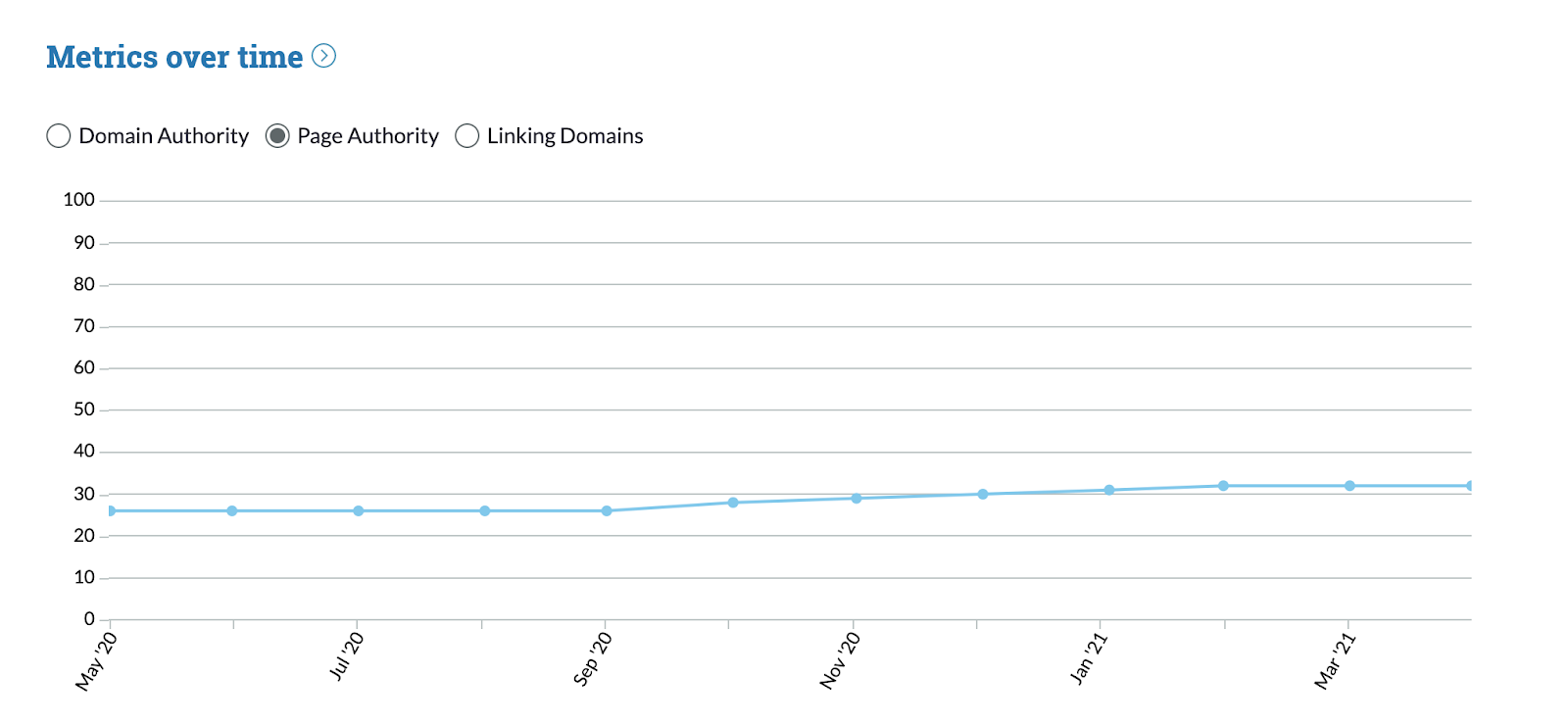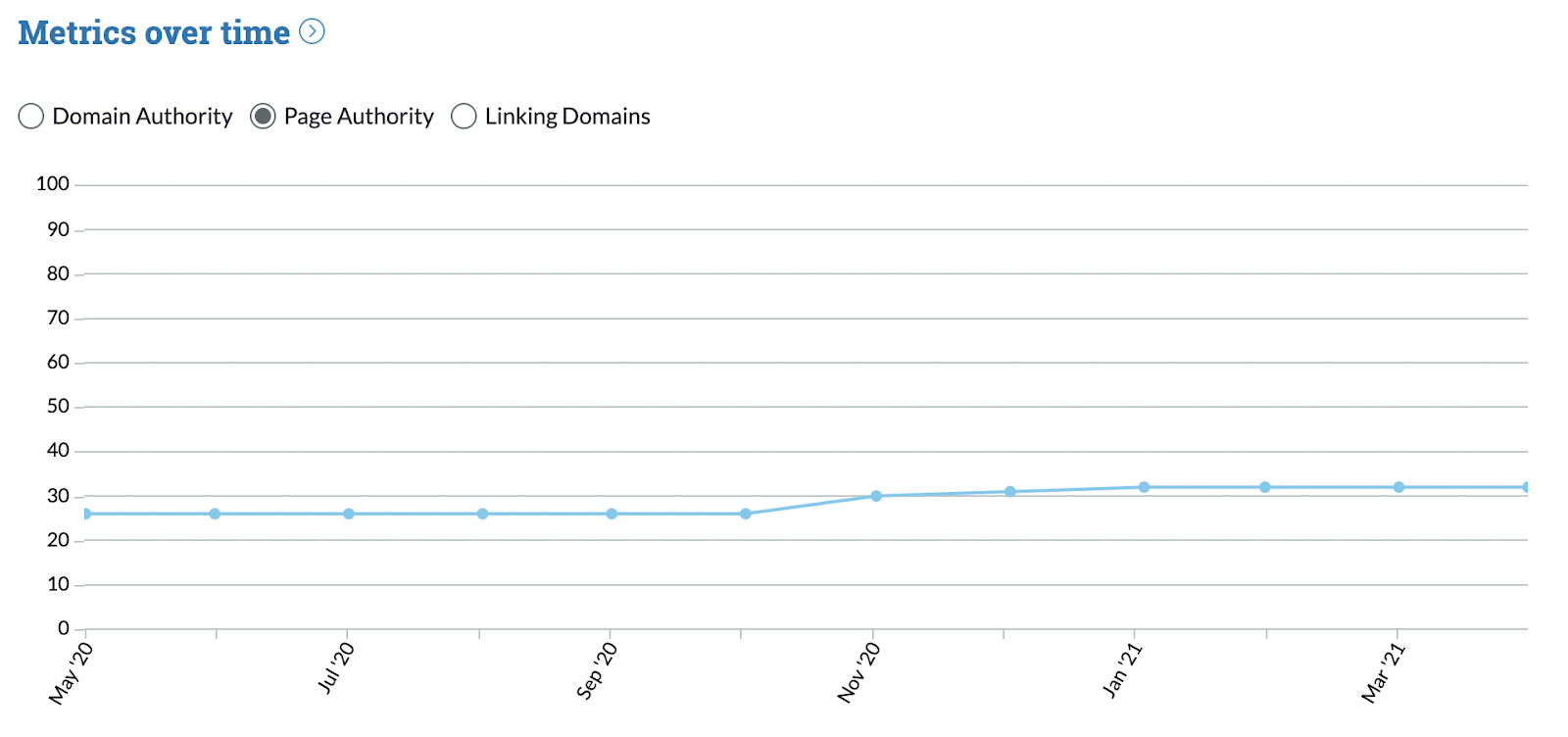Table of Contents
The situation
Truliant brought on Inseev Interactive as their link building provider in October, 2020. They came to Inseev with a goal of building links to their auto loans, mortgage loans, and checking pages. They also wanted to focus on two of their Learn hub pages. The target hub pages are home to all of the content for the home ownership and car buying tips related posts. Inseev’s goal was building ten highly authoritative and relevant links to these target pages each month. When the campaign kicked off, Truliant had a strong organic presence. With roughly 1,000 backlinks from unique domains their overall backlink profile was strong. For this reason, the campaign focused on a page authority growth approach.
You may be asking yourself, “what’s a page authority growth approach?”.
Certain pages on your site could be in a position where they are just a few backlinks away from ranking competitively for their target keywords. In this case, it can help to build links to those specific pages. This is where building links to specific pages versus an entire site, can help significantly increase ROI on linking efforts. These same pages could be your revenue-driving pages where you’ll benefit most from organic growth. This happened to be the case for Truliant.
As you read through this case study, you’ll see the unique circumstances and outcomes that make a page authority growth approach the right fit for a given website.
The Strategy
In an effort to start the campaign with as much momentum as possible, the initial focus was on branded opportunity. Branded strategies require a certain degree of brand presence prior to link building. Thanks to Truliant’s community involvement, there was a relatively strong digital footprint to start.
Branded Strategies
Strategy #1 Unlinked Mentions
The first branded strategy identified unlinked mentions of Truliant. These unlinked mentions included all variations of Truliant’s brand name as well. For example, Truliant FCU, Truliant Federal Credit Union, Truliant Credit Union, etc. Once you’ve identified these unlinked mentions, you can reach out to the appropriate contact and request to update the mention with a clickable hyperlink back to your site.
Consider ways that you can incentivize or add value to your request. Is there outdated information or a typo on the page that you could bring to attention with your request? Is there a broken link on the page? What can you do to add value in exchange for requesting a quick update on the page?
Expert Advice: If you are attempting to utilize this strategy for a brand name that is synonymous with a common term, i.e. Apple, implement Google search operators to help narrow down your results.
- “Apple” + “Steve Jobs”: this will return results that mention Apple and Steve Jobs
- “Apple” or “Steve Jobs”: this will return results that mention Apple or Steve Jobs
- “Apple” around(2) “Steve Jobs”: this will return results that mention Steve Jobs within two words of the word Apple
In addition to searching for mentions of the brand name, you can search for C-suite executives, successful ad or PR campaigns or any other initiatives that have garnered recognition for the company. This approach can also be used in tandem with active PR campaigns, as the campaign generates new press recognition, keep tabs on all features and ensure they include a backlink!
Inseev identified 1500+ opportunities for this strategy, securing 35 links with a 2.5% conversion rate.
Strategy #2 Broken Links
This strategy is a two-part approach, focusing on broken links or 404 pages. Part one focuses on broken links on your website, part two focuses on broken links on your competitor’s websites.
Part one – your website: this strategy identifies 404 pages on your site with backlinks pointing to them. Conduct your outreach with a request to update the broken link from the pages linking back to the 404.
It’s important to note that setting up 301’s for 404 pages will allow most of the link authority to flow to the new page, given that the replacement page is a good 1:1 match. This means that if you have a good replacement page for the 404, you’re better off setting up a 301 redirect and leaving the backlinks alone. If you don’t have a good replacement page, this is where conducting manual outreach can be helpful. As you are vetting the sites that you want to reach out to, consider whether it makes sense to pitch your new page. If you don’t have a good replacement page for a 301, you may not have a good replacement page for manual outreach either.
You may also find that the posts linking back to your 404 pages are significantly outdated. If this is the case, you may benefit more from collaborating on a new post with the site versus having a 5 year old link updated.
In addition to 404 pages, assess whether or not your website has outdated pages or pages with minimal SEO value that you can “sculpt” links away from. For example, About Us, FAQ or search pages with backlinks can likely be updated to more valuable targets.
Part two – competitor websites: this strategy identifies 404 pages on your competitor’s websites with backlinks pointing to them. This strategy is tough. It’s tough for a few reasons. The first is that your competitors are likely already working the broken backlinks in their profile, the second is that you may not have a good replacement page for your competitor’s broken links, the third is that the process can be tedious at times. Despite these challenges, don’t be discouraged, when you can secure these links, they add a ton of value, so stay on the lookout for these types of opportunities.
Inseev identified 250+ opportunities for this strategy, securing 18 links with a 2.6% conversion rate.
Strategy #3 Link Addition
This approach can be a goldmine depending on what site your industry is in. Your industry can also influence the ways this tactic can be utilized. This strategy aims to identify pages with existing backlinks where it makes sense to offer your page in tandem with the existing link. For Truliant’s campaign, this worked best on existing backlinks to their social profiles. Start by identifying pages that are linking to your social pages but not your actual website and reach out with a request to add a link back to your site. Utilize language like, “this way your users can easily find out more about us!”.
This strategy can be utilized for 3rd party reseller pages (i.e. Amazon, Nordstrom, Target, any other retailers who sell your products), other domains (if you own any), social profiles of your C-suite executives, podcasts, e-books or any other asset that you own that lives on a platform other than your website.
Inseev identified 350+ opportunities for this strategy, securing 6 links with a 1% conversion rate.
Hybrid – Brand & Non-Brand Strategy
Strategy #4 Ego-Bait
This is one of our personal favorites and one we haven’t heard of other link builders utilizing. We also love this strategy because you can generate new opportunities, basically, at your own discretion. This strategy identifies existing external links on your site and aims to secure a placement on a Press, About Us, or Featured On page on a third party website. (This works best with external editorial links on your own site).
It’s important to note that this strategy blurs a bit of a “grey” area in terms of reciprocal linking. For a backlink to be flagged as reciprocal generally requires a 1:1 match. This means that the page being linked to and the page linking back need to be the same URL structure.
In addition to not being a 1:1 match, this is a relatively safe linking practice and is a type of website behavior that happens organically. It’s also a fairly easy ask as a result. If the website you are requesting a link from, already maintains a Press page, your feature may have ended up there naturally!
As we mentioned, the other reason we love this strategy is because you can easily generate new opportunities. Simply write more editorial content for your site, feature the 3rd party websites you want links back from in the content, and conduct your outreach letting them know about their feature on your site! It’s best to try and pick sites that have a News or Press page so that the ask already makes sense.
Inseev identified 70+ opportunities for this strategy, securing 2 links with a 1% conversion rate.
Non-Brand Strategies
This next round up of strategies can be utilized for websites that have zero brand recognition. These are the strategies that are helpful to sites who are starting from the ground up.
Strategy #5 Thought Leadership
For this tactic, we leveraged the expertise and authority of the leadership team at Truliant. The Truliant team has a full suite of C-level executives with a broad range of expertise. They also have a senior management team, allowing for a robust database of experts across a number of different industries. In an effort to execute on a highly relevant link building campaign, we started our thought leadership initiatives around team members who had the closest experience to finance. This thought leadership approach can take many forms and is somewhat of a bucket term for a variety of tactics. This approach can include providing quotes, participating in interviews and podcasts, or becoming a regular contributor to relevant publications. This strategy relies heavily on relationship building and becoming a go-to source for publishers. These link building initiatives tend to pick up momentum as you execute on them for longer periods of time as the greater someone’s reputation is, the easier it is to create new relationships.
Inseev identified 250+ opportunities for this strategy, secured 14 links with a 2.5% conversion rate.
Strategy #6 Pitching as a Resource
This is a tough but extremely rewarding tactic available to link builders. It has a notoriously low conversion rate but can yield some of the highest value-driving links out there. This approach requires you to create high-quality and competitive content. Without investing serious time and energy into the assets on your site, this strategy won’t work. The content medium you can utilize for this strategy are uncapped, you just need to make sure that there is a sincere value add for third party websites providing a link back to the resource. You could create your resource as a webinar, blog post, or workshop series. This strategy also has the potential to yield significant organic link placements, assuming that your target audience responds well to the content. If you can leverage this strategy with the existing content on your site then you can get started right away. If you need to develop content prior to starting the strategy, make sure to conduct thorough research ahead of time. While this may initially seem like a setback, it can actually be a great way to develop an asset with the goal of making it linkable.
In our experience, we find the most linkable assets have a call-to-action or appeal to logic, emotions or ethics. In addition to considering this aspect, think about the topical volume and appealing to your target audience. You want to identify a focus for the piece that has a significant reach. The greater the interest around the topic, the better chance there is to identify more linking opportunities for your asset.
Once you’ve identified which asset you are going to leverage for link building, start prospecting for opportunities. Here are some helpful examples of search queries we like to use:
“asset topic” inurl:resource
“asset topic” inurl:helpful-links
“asset topic” + “resources” or “helpful links”
Inseev identified X opportunities for this strategy, secured 3 links with a 0.5% conversion rate.
Results
Over a 7 month span of link building, this campaign secured a total of 77 backlinks for Truliant FCU’s website, consistently exceeding the quota by 10%. Of the 77 links acquired, over 70% were to our target pages.
Strategy #1
The organic profile of the target pages saw improvements that correlated with the linking initiatives. While linking is not the sole influence of ranking improvements, the growth and link building correlation make a strong case that the linking efforts helped to support organic growth strategies.
Checking Page:

Mortgage Page:

In addition to ranking keyword and traffic growth, we also saw improvements on the Page Authority (PA) score from Moz on the same pages.
Checking Page: +3 increase

Mortgage Page: +5 increase


 End-to-end outreach workflow
End-to-end outreach workflow



 Check out the BuzzStream Podcast
Check out the BuzzStream Podcast

